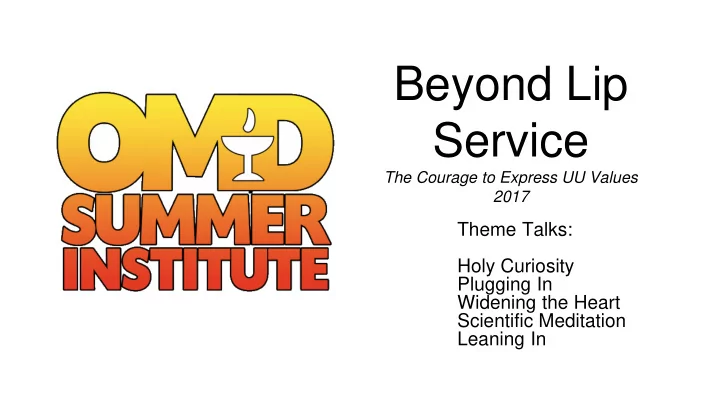

Beyond Lip Service The Courage to Express UU Values 2017 Theme Talks: Holy Curiosity Plugging In Widening the Heart Scientific Meditation Leaning In
https://www.youtube.com/watch?v=DgaeHeIL39Y&list=PLVlZrWIzwDWJS iUDKjBl_4V_jqxSRp32X (Sample conversation about needs)
Assumptions of NVC 1. Universality of human needs 2. Feelings result from needs being met or unmet 3. Actions result from needs 4. Natural giving 5. Sufficiency
The Bedrooms of Children Around the World https://www.youtube.com/watch?v=lJx4SkDhh7I
Marshall Rosenberg’s Nine Basic Universal Needs: Safety Sustenance Intimacy Understanding Honesty Rest/Recreation Community Autonomy Meaning/Contribution
Conventional Patterns of Communication Denial of Responsibility: Attributing the cause of our actions or feelings to anything other than our needs such as other’s actions, dictated of authority, policies/ rules/regulations, group pressure, roles, uncontrollable impulses, diagnosis/ psych history, or vague impersonal forces ~ Bay NVC, 55 Santa Clara Ave, Suite 203, Oakland, CA 94610 www.baynvc.org
https://www.cnvc.org/sites/default/files/feelings_inventory_0.pdf
Words that indicate judgment mixed with feelings Connecting Across Differences, J.M. Connor and D. Killian
What Empathy Isn’t - Top 10! Connecting Across Differences, J.M. Connor and D. Killian, p. 72 1. Advice-giving 2. Reassurance 3. Denial of Feelings 4. Minimization 5. I Can Top That! 6. Sympathy 7. Comparing Stories 8. Avoidance 9. Diagnosis 10.Judgment
"Out beyond ideas of wrongdoing and rightdoing there is a field. I'll meet you there. When the soul lies down in that grass the world is too full to talk about." Rumi
Restorative Ju Justic ice His istory and Defin initions • Although the term “restorative justice” encompasses a variety of programs and practices, at its core it is a set of principles, a philosophy, an alternate set of “guiding questions.” Ultimately restorative justice provides an alternative framework for thinking about wrongdoing. Zehr (2015) • Restorative justice is a way of looking at criminal justice that emphasizes repairing the harm done to people and relationships rather than only punishing offenders. Zehr (1990) • In the modern context, restorative justice organized in the 1970’s as mediation or reconciliation between victims and offenders.The concept subsequently acquired various names, such as victim-offender mediation and victim- offender dialogue. I nternational Institute of Restorative Practices website (IIRP) • Restorative justice is reactive, consisting of formal or informal responses to crime and other wrong doing after it occurs.
The Little Book of Restorative Justice (Revised and updated) Howard Zehr - 2015
RESTORATIVE SYSTEM BUILDING If we haven't consciously chosen a system, it is likely to be the one we inherited, which for many of us in the United States, is a retributive or punitive system. A variety of restorative practices (see next slide) that can by used and adopted by the community (school, church, family, workplaces) to: • reduce violence and bullying • improve human behavior • strengthen community • provide effective leadership • restore relationships • repair harm • Restorative Justice practices are a “response to harm” after the event. • Restorative practices is an opportunity to build social resilience before harm occurs. We have a choice. We can "own" our conflicts and choose together how we wish to address them. What works? What doesn't work? How would we like it to be?
Res esto torativ ive Prac ractices es Con Contin inuum Formal Informal Low High Resources Resources & & Time Time
Cir Circles A circle is a versatile restorative practice that can be used proactively, to develop relationships and build community or reactively, to respond to wrongdoing, conflicts and problems. Circles give people an opportunity to speak and listen to one another in an atmosphere of safety, decorum and shared power. ~International Institute of Restorative Practices (IIRP) 2017
Basic Elements of Circle Process A Little Book of Circle Process, by Kay Pranis ● Opening and Closing ● Talking piece ● Time for Sharing ● Circle Keeper ● Consensus ● Agreed upon Guidelines ● Optional: Centerpiece, food, etc
RESOURCES Connecting Across Differences: Finding Common Ground with Anyone, Anywhere, Anytime By Jane Marantz Connor and Dian Killian Center for Non-Violent Communication at https://www.cnvc.org/ International Institute for Restorative Practices at http://www.iirp.edu/ Compassionate Communication Center of Ohio at https://www.speakingpeace.org/ Partners In Restorative Initiatives at http://www.pirirochester.org/ A Little Book of Circle Process by Kay Pranis Tara Brach Meditation Resources https://www.tarabrach.com/meditation-relaxing-back-saying-yes/
Recommend
More recommend